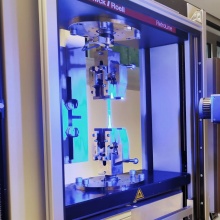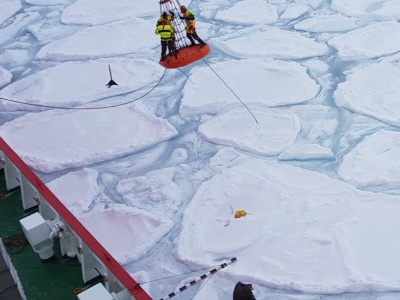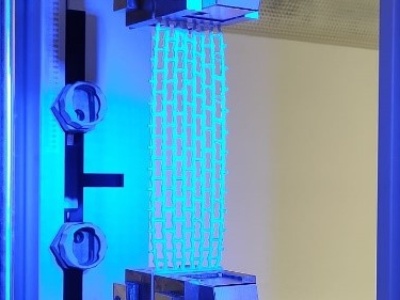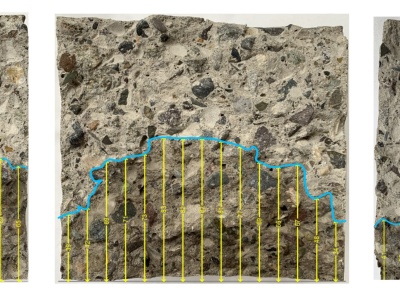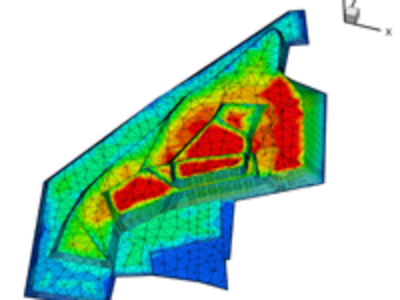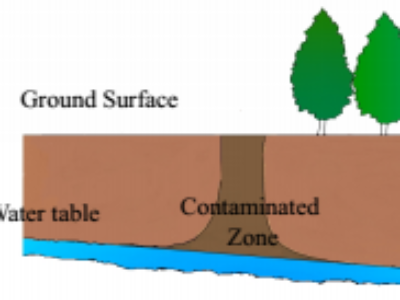Experimental mechanics is a branch of engineering mechanics used to solve engineering problems using measurements, and can be defined as the investigation of the mechanical behaviour of an object under load or excitation by conducting experiments. The measured mechanical quantities conventionally associated with experimental mechanics are the following: deformations, which can serve as a basis for the determination of stresses or loads (forces, torques); accelerations, velocities, displacements, angles, etc. In addition to the conventional quantities, any aspect relevant to a given object can be measured or recorded by photographic or video recording, in order to determine more effectively the actual state by experimental methods, while knowledge of this actual state can subsequently facilitate a clearer description, i.e. the mathematical formulation of the phenomenon.
From remediation activities in soil to pancake formation in the antarctic ice shelf, environmental mechanics covers a large portion of natural activity surrounding us. Originating in the field of civil engineering, environmental mechanics concerns itself with a multitude of questions of mechanical nature, such as stability, structural analysis and the influence of coupled processes on these, such as bacterial activity or advection of pollutants.
Publications
2025
- Pathak, R., Seyedpour, S. M., Kutschan, B., Thoms, S., & Ricken, T. (2025). A coupled multiscale description of seasonal Physical–BioGeoChemical dynamics in Southern Ocean Marginal Ice Zone. Environmental Modelling & Software, 185, 106270. https://doi.org/10.1016/j.envsoft.2024.106270
- Azhdari, M., Rezazadeh, G., Ricken, T., Pathak, R., Tautenhahn, H.-M., Tautenhahn, F., & Seyedpour, S. M. (2025). Temperature distribution in multi-layered skin tissue during laser irradiation considering epidermis sublayers: Virtual Element Method approach. Thermal Science and Engineering Progress, 59, 103297. https://doi.org/10.1016/j.tsep.2025.103297
- Ali Mirza, Z., Azhdari, M., Kolomenskiy, D., Rezazadeh, G., Ricken, T., Pathak, R., Tautenhahn, H.-M., Tautenhahn, F., & Seyedpour, S. M. (2025). Enhancing laser therapy procedure through surface temperature control in multi-layered skin tissue. Journal of Thermal Biology, 129, 104106. https://doi.org/10.1016/j.jtherbio.2025.104106
2024
- Pathak, R., Seyedpour, S. M., Kutschan, B., Thom, A., Thoms, S., & Ricken, T. (2024). Modeling freezing and BioGeoChemical processes in Antarctic sea ice. Pamm, 24, Article 2. https://doi.org/10.1002/pamm.202400047
- Pi Savall, B., Seyedpour, S. M., & Ricken, T. (2024). Experimental Analysis of Strain and Thermal Behaviour on 3D Printed Flexible Auxetic Structures. In Lectures Notes on Advanced Structured Materials 2 (pp. 85–102). Springer Nature Switzerland Cham.
- Pi Savall, B., Seyedpour, S. M., & Ricken, T. (2024). Experimental Analysis of Strain and Thermal Behaviour on 3D Printed Flexible Auxetic Structures. In H. Altenbach, L. Hitzler, M. Johlitz, M. Merkel, & A. Öchsner (Eds.), Lectures Notes on Advanced Structured Materials 2 (pp. 85–102). Springer Nature Switzerland. https://doi.org/10.1007/978-3-031-49043-95
- Grünfelder, N., Savall, B. P., Seyedpour, S. M., Waschinsky, N., & Ricken, T. (2024). Exploring the dependencies of Poisson’s ratio in auxetic structures. Pamm, 24, Article 3. https://doi.org/10.1002/pamm.202400073
- Soltani, K., Seyedpour, S. M., Ricken, T., & Rezazadeh, G. (2024). Transient high-frequency spherical wave propagation in porous medium using fractional calculus technique. Acta Mechanica, 235, Article 4.
- Brodbeck, M., Suditsch, M., Seyedpour, S. M., & Ricken, T. (2024). Phase transition in porous materials: effects of material parameters and deformation regime on mass conservativity. Computational Mechanics. https://doi.org/10.1007/s00466-024-02557-2
- Arasteh-Khoshbin, O., Seyedpour, S. M., . Mandl, L., Lambers, L., & Ricken, T. (2024). Comparing durability and compressive strength predictions of hyperoptimized random forests and artificial neural networks on a small dataset of concrete containing nano SiO2 and RHA. European Journal of Environmental and Civil Engineering, 0, Article 0. https://doi.org/10.1080/19648189.2024.2393881
- Trivedi, Z., Wychowaniec, J. K., Gehweiler, D., Sprecher, C. M., Boger, A., Gueorguiev, B., D’Este, M., Ricken, T., & Röhrle, O. (2024). Rheological Analysis and Evaluation of Measurement Techniques for Curing Poly(Methyl Methacrylate) Bone Cement in Vertebroplasty. ACS Biomaterials Science & Engineering, 10, Article 7. https://doi.org/10.1021/acsbiomaterials.4c00417
2023
- Seyedpour, S. M., Thom, A., & Ricken, T. (2023). Simulation of Contaminant Transport through the Vadose Zone: A Continuum Mechanical Approach within the Framework of the Extended Theory of Porous Media (eTPM). Water, 15, Article 2. https://doi.org/10.3390/w15020343
- Seyedpour, S. M., Henning, C., Kirmizakis, P., Herbrandt, S., Ickstadt, K., Doherty, R., & Ricken, T. (2023). Uncertainty with Varying Subsurface Permeabilities Reduced Using Coupled Random Field and Extended Theory of Porous Media Contaminant Transport Models. Water, 15, Article 1. https://doi.org/10.3390/w15010159
- Arasteh-Khoshbin, O., Seyedpour, S., Brodbeck, M., Lambers, L., & Ricken, T. (2023). On effects of freezing and thawing cycles of concrete containing nano-SiO 2: experimental study of material properties and crack simulation. Scientific Reports, 13, Article 1. https://www.nature.com/articles/s41598-023-48211-4
2022
- Arasteh-Khoshbin, O., Seyedpour, S. M., & Ricken, T. (2022). The effect of Caspian Sea water on mechanical properties and durability of concrete containing rice husk ash, nano-SiO2, and nano-Al2O3. Scientific Reports, 12, Article 1. https://doi.org/10.1038/s41598-022-24304-4
2021
- Seyedpour, S., Valizadeh, I., Kirmizakis, P., Doherty, R., & Ricken, T. (2021). Optimization of the Groundwater Remediation Process Using a Coupled Genetic Algorithm-Finite Difference Method. Water, 13, Article 3. https://doi.org/10.3390/w13030383
- Pi Savall, B., Mielke, A., & Ricken, T. (2021). Data-Driven Stress Prediction for Thermoplastic Materials. Pamm, 21, Article 1. https://doi.org/10.1002/pamm.202100225
- Seyedpour, S. M. (2021). Simulation of contaminant transport in groundwater: From pore-scale to large-scale [Publication]. Shaker Verlag.
2019
- Seyedpour, S. M., Janmaleki, M., Henning, C., Sanati-Nezhad, A., & Ricken, T. (2019). Contaminant transport in soil: A comparison of the Theory of Porous Media approach with the microfluidic visualisation. Science of the Total Environment, 686, 1272–1281.
- Seyedpour, S. M., Kirmizakis, P., Brennan, P., Doherty, R., & Ricken, T. (2019). Optimal remediation design and simulation of groundwater flow coupled to contaminant transport using genetic algorithm and radial point collocation method (RPCM). Science of the Total Environment, 669, 389–399.
2018
- Seyedpour, S. M., Panagiotis, P., Rory, R., & Ricken, T. (2018). Theory of Porous Media approach to simulation of contaminant transport in groundwater: verifying the numerical results with sandbox experiment. EGU General Assembly Conference Abstracts, 20, 16944.
2016
- Seyedpour, S. M., & Ricken, T. (2016). Modeling of contaminant migration in groundwater: A continuum mechanical approach using in the theory of porous media. Pamm, 16, Article 1.
2014
- Babazadeh Shayan, S., Seyedpour, S. M., & Ommi, F. (2014). EFFECT OF FUEL ADDITIVES ON GASOLINE VOLATILITY.
- شایان, بابازاده, سهیل, سیدپور, سیدمرتضی, امی, & اله, فتح. (2014). تاثیر افزودنی های سوختی بر فراریت بنزین. نشریه مهندسی مکانیک امیرکبیر, 46, Article 1.
2012
- Babazadeh Shayan, S., Seyedpour, S. M., & Ommi, F. (2012). Effect of oxygenates blending with gasoline to improve fuel properties. Chinese Journal of Mechanical Engineering, 25, Article 4.
2011
- Babazadeh Shayan, S., Seyedpour, S. M., Ommi, F., Moosavy, S. H., & Alizadeh, M. (2011). Impact of methanol–gasoline fuel blends on the performance and exhaust emissions of a SI engine. International Journal of Automotive Engineering, 1, Article 4.
Researchers

Seyed Morteza Seyedpour
Dr.-Ing.Head of Laboratories, Head of Experimental Mechanics & Enviromental Engineering Group, Researcher


